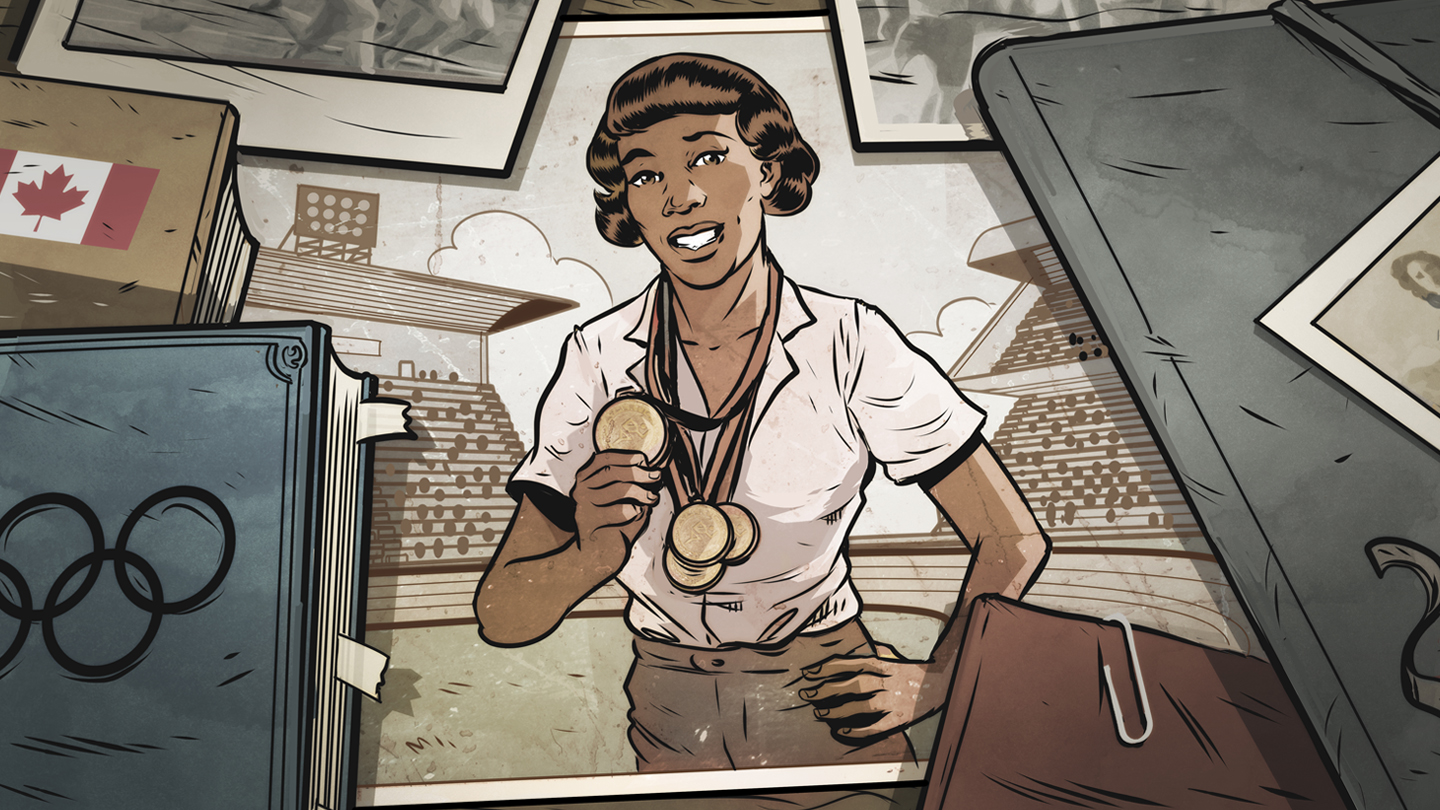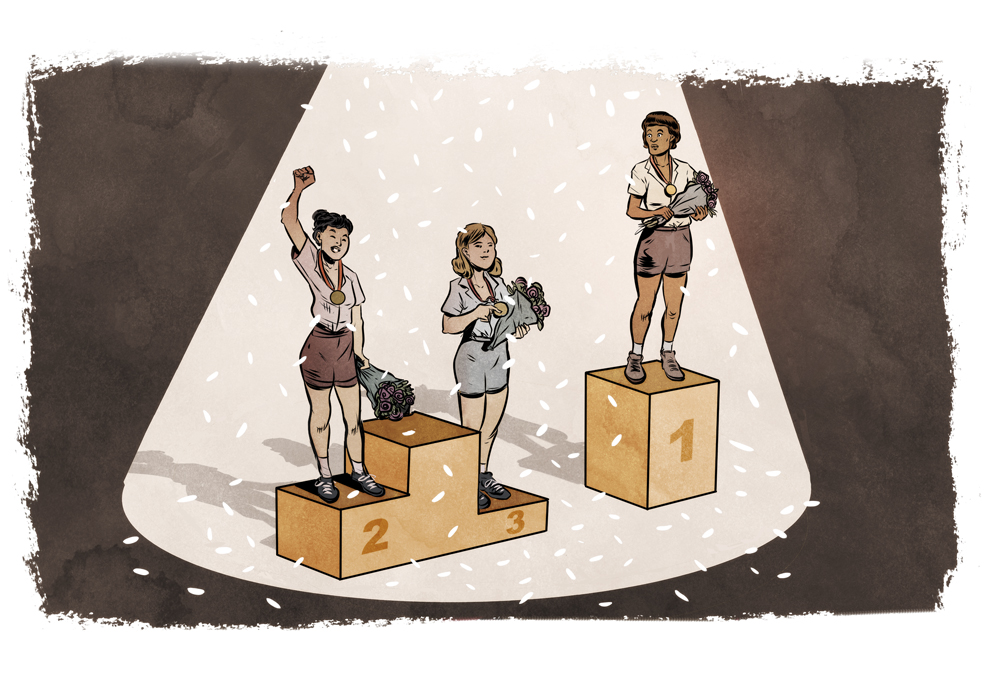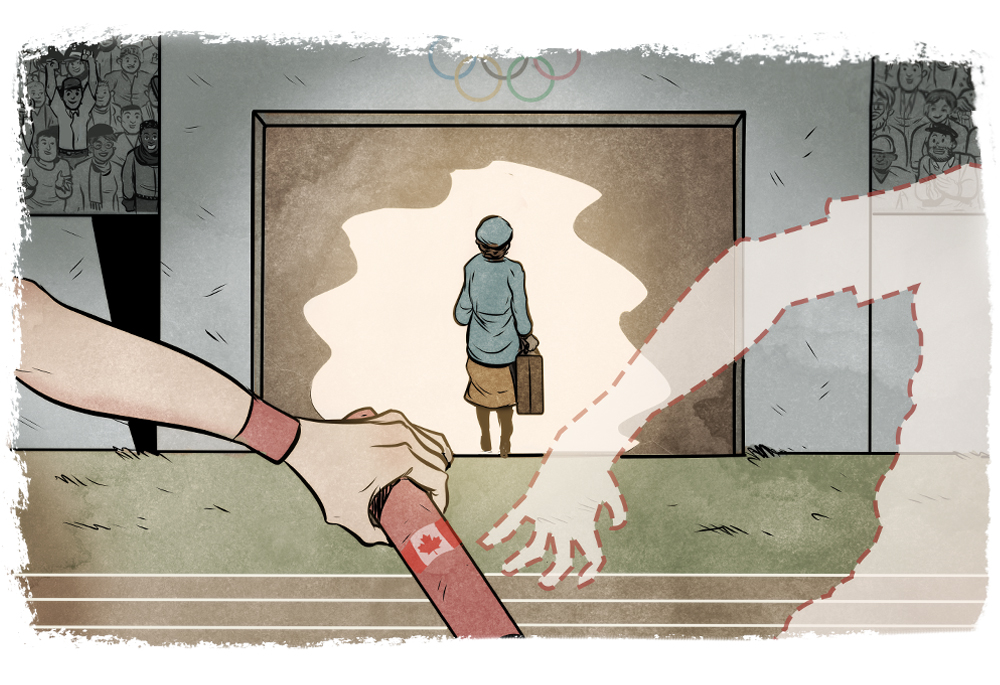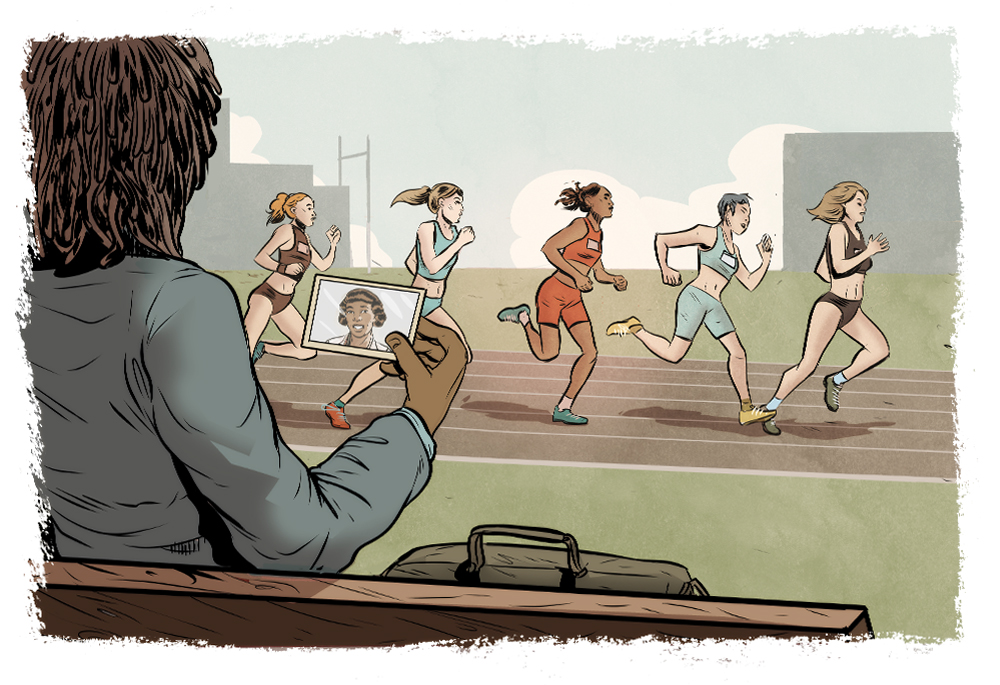THE ONLY ONE

E ven just in the pictures, there was something captivating about Jean Lowe. They were black-and-white; shots that had originally run alongside newspaper columns and yearbook entries from the 1930s and ’40s. There was one of Lowe in mid-stride from a 1948 Globe and Mail article, her hands balled in fists, her expression calm, her eyes on the track ahead of her. Another was from her junior year at Toronto’s Eastern High School of Commerce, Lowe standing with her hands clasped behind her alongside two of the school’s other “field day champions.” There were larger group photos, too, shots of entire track-and-field teams posed in skirts and blazers. In all of them, Lowe was the lone Black athlete.
Ornella Nzindukiyimana came across the pictures as a doctoral student at Western University. From her earliest encounters with what was left of Lowe’s story, she knew she wanted to find out everything she could. “I was just interested in why she seemed to be the only one,” says Nzindukiyimana, now a professor of human kinetics at St. Francis Xavier University in Antigonish, Nova Scotia. “So, I was trying to pinpoint what that means. As Black people, we’ve all been there, being the only one, and what does that mean in the 1940s?”
That question would prove challenging to answer. Black histories are often inadequately archived, and oral accounts of Black lives, families and communities have long been considered less legitimate in academia. Combing archives from the period, Nzindukiyimana pieced together Lowe’s story for her doctoral dissertation, and in the process, basically rediscovered a figure who was once one of Canada’s most decorated amateur athletes.
Already a standout sprinter at Eastern Commerce when she joined the Toronto Laurels Ladies’ Athletic Club, Lowe set the 220-yard record at the 1941 Ontario indoor athletics championship and added the women’s indoor 100-yard record the following year. At the 1942 Ontario track and field championships, she won five events. She then went on to captain a Laurels relay team that dominated American Amateur Union (AAU) meets, winning the 1943, ’44 and ’45 AAU championships in Ohio. At that same meet, Lowe’s 100-metre time – 11.9 seconds – broke the Canadian record set by Myrtle Cook in 1928.
These accomplishments were fairly well-covered in Lowe’s day, but the coverage was — perhaps predictably — flawed. Columnists highlighted her athletic gifts but also hedged when estimating her potential. She was described as “a credit to her race” and the terms “dusky” and “negress” were used with regularity. Lowe was celebrated, but Other. She was a great athlete, but a Black athlete.
And then she was a forgotten athlete. Today, few Canadians have ever heard of this important figure in the history of sport in this country.
Nzindukiyimana set out with a key question in mind — what did it feel like to be the only one? — and her work raised more: Why don’t we know the name “Jean Lowe”? What lessons can her career teach us about the ways we talk about, treat and nurture Black athletes? And what should we take from the fact that she left Canada in her athletic prime and never returned?

B orn in Toronto in 1922, Alice Maud Eugenia Lowe Butler’s athletic achievements rippled across Canada during the 1930s and 1940s. At Eastern Commerce, juggling work and her studies, she also excelled in half a dozen sports, including basketball and softball. It was on the track, though, that she shone the brightest. She was crowned Eastern’s junior and senior girls’ track champion and shattered school records in multiple events.
She was also a standout member of several local sports clubs. She competed with the Toronto Ladies Club — the envy of many similar organizations because it funded activities like basketball, hockey and track-and-field — and the Hope United team, where she led the Toronto Women’s Basketball League in scoring and won a title in 1944. There was also her captaincy with the Laurels, who made so much noise stateside.
In 1942, Lowe met Cleve L. Abbott, athletic director at the Tuskegee Institute, a historically Black university in Tuskegee, Alabama, founded by Booker T. Washington. Abbott was a landmark figure in amateur sports in that state. In 1936, he’d created the Tuskegee Relays, “which became an important competition for high school Black girls in Dixie states,” Nzindukiyimana writes. “Over the years, athletes from the Relays were recruited and offered work/study scholarships to the Institute, and helped the school dominate AAU competitions for two decades thereafter. Some of the Tuskegee program’s recruits, Alice Coachman [the first Black woman to win Olympic gold] among them, also went on to impress at the Olympics.”
Having competed against the Tuskegee Tigerettes at the AAU meets where she made such a mark, it’s not hard to imagine Lowe standing out to Abbott, who, Nzindukiyimana writes, was “always looking for good runners.” The specific role he played in her decision to leave Canada for Alabama in 1945 is unclear, but when she applied to become a naturalized American citizen in 1948, Abbott served as a witness on her behalf.
“Her sudden departure from Toronto at the [Second World] War’s close seems to indicate that the best opportunity open to her was outside of the country,” says Nzindukiyimana. Lowe’s personal reasons for leaving — along with nearly all of her life not contained in track records and newspaper headlines — seem lost to history, a predictable consequence of our failure to properly recognize the significance of her story for so long. She did return to Canada to compete, though, and contemporaneous accounts of the 1948 Canadian Olympic Trials may provide some hint as to why that meet served as Lowe’s last act in Canadian colours.
Those 1948 Games were Lowe’s first opportunity to represent Canada on the Olympic stage. Considered the country’s best chance in the sprinting events by local columnists, she would fail even to podium at Trials. After that disappointing meet, athletic bodies, including the Women’s Amateur Athletic Federation of Canada, were accused of favouring certain athletes in the Trials. Lowe’s coaches lodged complaints to that effect with the WAAF, which were documented in the Globe and Mail, where columnist Bobbie Rosenfeld also wrote she was convinced that athletes from British Columbia had received better treatment — five BC athletes were selected to the Olympic team, of seven spots — and wondered whether “any whisper of discrimination reached the ears of Jean Lowe, Toronto’s colored trackster.”
Comparing Lowe’s situation to that of Rosella Thorne, another prominent Black athlete who had won the 80-metre hurdles and still was left off the team, Rosenfeld pointed out that Lowe’s poor performance was “unusual for a gal who repeatedly has shown the way in the 200 metres.”
We can’t know for sure whether racial discrimination by the sporting establishment was the reason Lowe left Toronto to live in the Southern United States at the height of racialized violence there. Ultimately, Nzindukiyimana was trying to find an understanding of Lowe’s athletic life that we could take away in our own lives — but too much has been lost for anything but a partial portrait to be painted. Even in that incomplete picture, though, there is immense value.
The pieces of Lowe’s story continue to resonate because Black athletes in this country still face many of the same barriers and attitudes she did. That the facts of her life were lost for so long is telling, but Nzindukiyimana’s effort to dig them up and reassemble them should inspire hope. The professor’s efforts are part of a growing movement in Canadian academia to bring truth to the historical record, to shine a light on the ways Black people have shaped the country, and learn what we can from what’s left of stories like Lowe’s. She is not the only significant Black-Canadian athlete to be overlooked and nearly forgotten. There are others, and now more than ever before, we are looking for them.

B lack Studies — an interdisciplinary academic field that focuses on the history, culture, and politics of the African diaspora — is occupying more space than ever at Canadian universities. Toronto’s York University offers a Black Canadian studies certificate, which can be pursued independently or as a companion to an undergraduate degree. In 2016, Dalhousie University in Halifax began offering a Black African Diaspora minor. Black Studies programs are also on the horizon at a number of other schools, including Concordia University in Montreal, the University of Waterloo, Queen’s University in Kingston, Ont. and Toronto’s X University.
The X University minor becomes available next fall. Housed in the school’s English department, it will nevertheless offer courses coming from 13 departments. The work that’s gone into developing the curriculum included hiring Black faculty to administer relevant courses, and from the beginning it’s been a labour of love. “Creating these programs – these minors, these certificates – is more difficult than folks can imagine,” says Professor Melanie Knight, a member of the working group — along with Professors Anne-Marie Lee-Loy and Cheryl Thompson — that’s laying the program’s foundation.
Black Studies is so many things, says Knight: “It’s Africa, it’s the Caribbean, it’s creative industries, it’s nursing. So we are saying [this program is] a beginning.”
Ultimately, the school’s measures of success in implementing the minor will be its uptake by students and its accessibility — how available they can make it for students who are interested but can’t fit it into their schedules. But in the meantime, as this program and others like it are being developed, Black researchers have to be supported in a deep way. “What I’ve been reminding and ensuring that people understand is that Black Canadian candidates — the Black faculty, the researchers that are here — have laboured to finish their work and to be in academia,” says Knight, who has spoken with other universities that want to begin similar initiatives. “We’re not in surplus. So if you see many of us [still] early on in our doctoral careers, that’s a result of systemic barriers. And so there is now the desire to obtain [Black faculty] without the desire to nurture and to support from the ground up — to make sure that we have people like Dr. Nzindukiyimana, who can be present and be behind.”
Citing the late bell hooks, Knight says what Nzindukiyimana has done with Lowe’s story is a “talkback” — proof that what is present speaks to us all and universalizes. “What we have [in Nzindukiyimana’s work], in fact, speaks to a diversified experience that’s not the case [currently],” she says. “And so we need Dr. Nzindukiyimana. To have her, though, requires work.”
The growth of these departments shows that we are starting to understand that Black stories deserve their time in the sun. And indeed, Jean Lowe’s story offers a window into how we talk about, treat and nurture Black athletes in Canada and elsewhere that still resonates. While an instance of explicit racism is not well documented in the available materials about her, Lowe’s presence in a culture that spoke about her a certain way and took away opportunities for success is recognizable to contemporary Black athletes, especially Black women.
That much became clear in the fall of 2021, when Ontario University Athletics, the provincial body that governs post-secondary sports, released a report detailing the organization’s racial demographics and experiences with racism in the programs it oversees. Based on interviews with 716 coaches, 4,058 students and 227 administrators, the report’s findings are vast.
Among them is confirmation that white coaches are hired at disproportionate rates and there is limited diversity among racialized coaches. Where athletes are concerned, there is a similar homogeneity outside of football and soccer. And across 56 universities nationwide, there is only one person of colour helming an athletic department — Kavie Toor at the University of British Columbia.
Black respondents overwhelmingly pointed out inequitable and discriminatory hiring practices. They related examples of microaggressions, and countless times they’d battled denials of systemic racism by privileged and powerful white administrators and the reinforcement of damaging stereotypes, including the idea of Black athletes as more durable and lower in intelligence. “That disparity between the people who know [racism exists] and the people who don’t know — I think that was the biggest surprise to me,” says Professor Janelle Joseph, who founded and leads the IDEAS Lab at the University of Toronto, which authored the report. “That there would be any person in today’s day and age that would say, ‘There’s no racism going on in my athletic department. It doesn’t happen here.’ That was actually a surprise to me.”

For Joseph, whose lab began working with the OUA in 2020, Black athletes’ tendency to connect with one another was also surprising — though in this case pleasantly. “The ways that, for example, Black female athletes at McMaster would go to play at Queen’s and make a connection with the one Black girl on that team, and that they would continue that networking through social media, through their personal chats and through email — they’re staying connected with each other.”
There’s also a burgeoning provincial and national network of racialized athletes who see that no one else is going to do it for them, Joseph adds. “It’s really like on-the-ground kind of activism,” she says. “No one is going to create a mentorship network for them, they need to do it themselves, and they’re being really active.”
Black athletes are persevering and creating community on a nationwide scale. But that trend is also further proof that something isn’t working within schools and governing bodies, and those institutions need to do more.
Lee Anna Osei, who founded the Black Canadian Coaches Association in 2020, argues there needs to be overarching, national standards of practice for hiring and more diverse hiring panels and committees, particularly in athletics departments. “U Sports is notoriously quoted as saying, ‘We’re the largest employer of professional sport coaches in the country.’ Yeah, but there is no standard for hiring across the country,” she says. “There is no standard for equitable practices for coaches who are employed across the country.”
Osei, who was the first Black coach in St. Francis Xavier’s history, says administrators and universities need to be more proactive in addressing every problem raised in the report — and then some. “I think everybody’s responses are validated. We know that research is what informs decisions and that’s actually part of the reason why institutions are so hostile towards marginalized groups, because they’re never in the majority,” says Osei, who herself played postsecondary basketball at Ontario’s Wilfrid Laurier University. “If anything, it quite literally is the tangible and fact-based and grounded work that informs institutions. So, here it is in the language that you understand.”
Getting stories like Jean Lowe’s down in that language is also crucial. To Joseph, Lowe’s example speaks loudly, with one theme in particular coming through strong and clear: supports, or the lack thereof. “If you’re talking about an athlete who is affluent, who’s come from a private school, who has all the academic background and family support and financial support that they need, then they can study for a couple of hours and then come to practice for a couple of hours. Whereas people who have not had that intergenerational strength provided for them, they need more supports,” says Joseph. “And it’s not because they’re dumb, and it’s not because they don’t know where to get them. It’s because they’re not available.”
Joseph notes that the OUA report has resonated in the right places. “I’ve been told that since the report emerged, there’s a standing agenda item on athletic directors’ regular meetings, across the OUA, to share what they’re doing to address anti-racism, and to try and create a concerted effort,” she says.
There is still work to do. But to have Joseph’s leadership and the concrete information the report provides to help fill gaps in knowledge already shows that better understanding Black experiences can make for better policy and better universities.
“My main objective is to amplify the untold stories, and correct the narrative, or to counter the erasure of Blackness from Canada,” says Joseph. “We have always been here and we will continue to shine. But it is especially important for me to do that in the sports realm because the body and the moving body and our sports structures are so central — and at the same time peripheral — to Canadian culture, to our education systems.
“Rinaldo Walcott [a professor at U. of T.] has been, for decades, talking about the surprise of Black Canadianness, because every time it’s like, ‘Oh, Black people do that?’ and ‘Oh, there were Black people there?’” Joseph continues. “I would really love it if we could move to a space where it’s not a surprise, it’s not marginal; it’s central and recognized as such. So that’s my mission in life.”
And that’s the mission of Professor Ornella Nzindukiyimana, who listened to her curiosity and brought Jean Lowe’s story out of the archives. And in that lesson, especially during Black History Month, we can find purpose. For her, it’s to correct the record.
“I think there’s a responsibility, especially because sports stories and sports people and sports successes are often the vehicle for these false narratives about the country — about tolerance, about all of those ideas about multiculturalism,” says Nzindukiyimana. “The sport historians are often there to say, ‘Wait a minute, so these women went to the Olympics, but then didn’t go anywhere,’ or, ‘This person was there on that team, absolutely. But then they left the country and never came back.’
“To me, I love the ability, every semester in my sport history class, to bring all of these notions and these great stories and kind of break them apart in front of the students who are very much of the notion of, ‘If they’re in, they’re in, and that’s the end of it.’ Jackie Robinson was in and, you know, therefore, racism was defeated in baseball forever and ever.
“I just want to indicate that these stories of people, of pioneers, of firsts, of successes are kind of covering up a bigger issue.”


